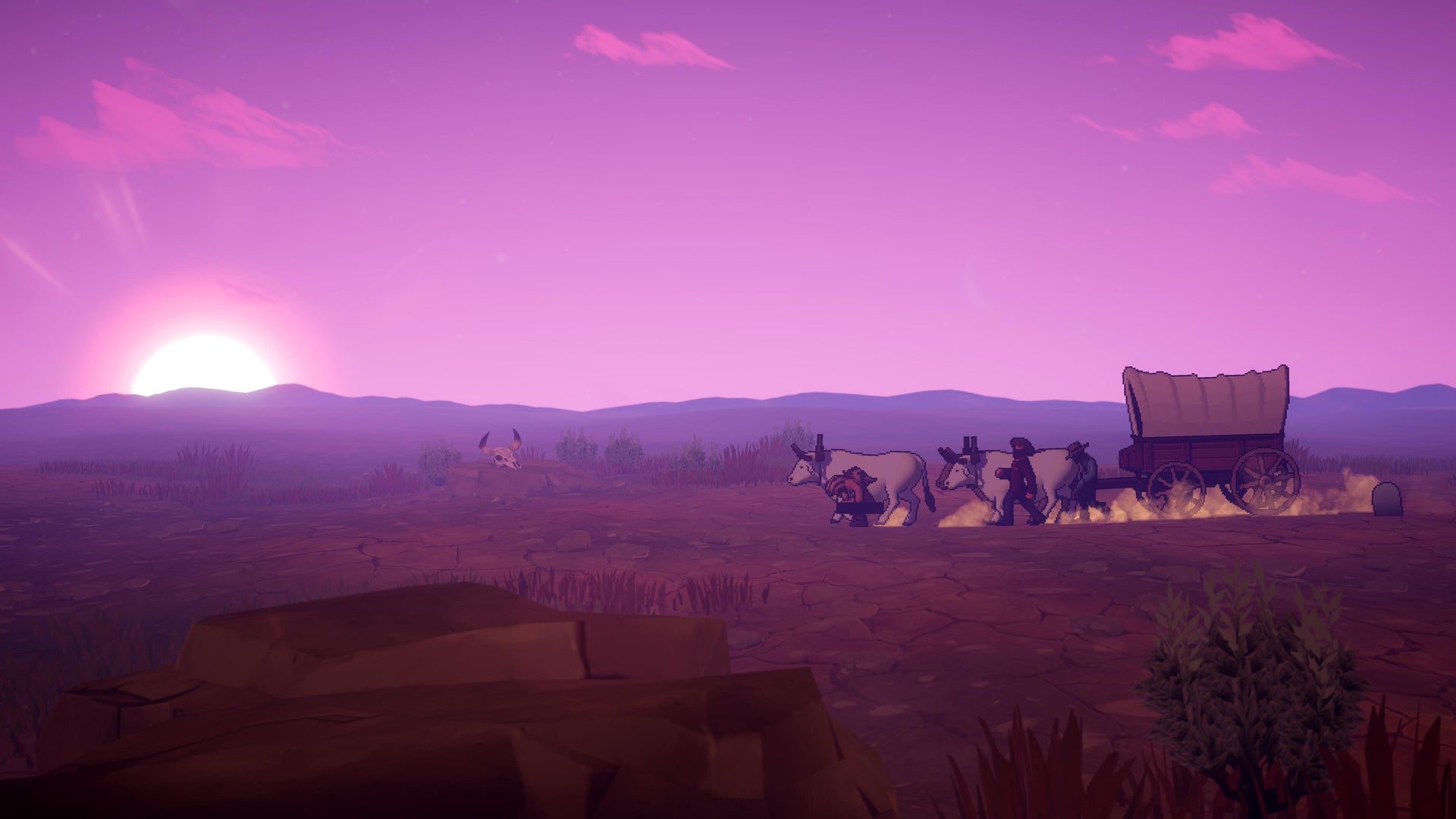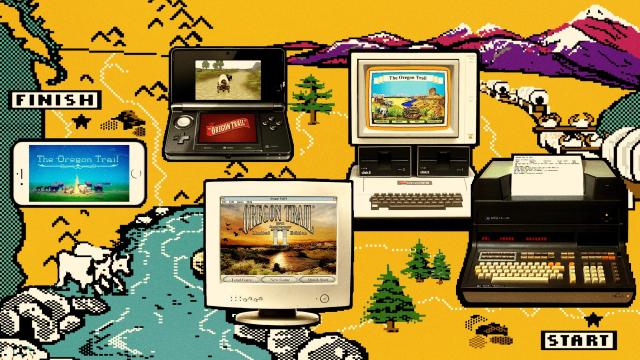In 1991, I pulled a chair up to an Apple II in my first-grade class and inserted a floppy disk with a faded, fraying label: The Oregon Trail.
I didn’t know how to play. I didn’t even know what an Oregon Trail was. Still, I was instantly hooked — and I wasn’t alone. My classmates and I gathered around The Oregon Trail at every study break, leaving Reader Rabbit to collect dust.
It was my first computer game, but I was far from the game’s first player. The students who struggled to conquer the original’s deadly journey were, by the time I booted the game, old enough to have children of their own. The Oregon Trail is now celebrating its 50th birthday and, in fact, the first video game franchise to survive half a century.
The Oregon Trail was originally played with printer
The Oregon Trail was going to be a board game.
Don Rawitsch, a student-teacher in Minneapolis, wanted a new way to teach history. He imagined a board game that would let students experience the Oregon Trail, managing resources and making life-or-death decisions along the notorious trek.
But his roommates, Paul Dillenberger and Bill Heineman, had a suggestion. What if The Oregon Trail was a computer game? Bryant Junior High, the school where the trio taught, had an HP 2100 computer, and Rawitsch’s roommates were learning to program in BASIC.
The trio cranked out the original The Oregon Trail in two weeks. It was a text-based game played through the teletype terminal and had no display. Instead, students typed in commands and received a printout of the results. The first player to die of a snakebite learned their fate from the slow cacophony of an early 1970s printer.
This original version was playable for only a week before Rawitsch had to move the teletype to another classroom. Fortunately, he ended the game’s run with a galaxy-brain decision: he printed a copy of the game’s code before it was deleted from the school’s computer.
In 1974, Rawitsch took a job with MECC and provided the game for use in the company’s library of educational titles. The Oregon Trail, like many games from this era, would’ve been lost forever if not for that single scroll.
The iconic Apple II release
The version of The Oregon Trail spat out of a printer in 1971 — about 800 lines of code in all — was a foundation. But it wasn’t the version that rose to stardom and eventually spawned countless memes. It was the game’s 1985 release for the Apple II that etched its legacy in the memory of a generation.
This technically wasn’t the game’s first release for the Apple II: the 1975 version was ported to the Apple II in 1978 and later distributed in a MECC software bundle called Elementary Volume 6. But, as you might imagine, a game originally designed for teletype began to show its age as home PCs capable of colour graphics transitioned from dream to reality.
R. Philip Bouchard, a software engineer hired by MECC in 1981 to improve the company’s software for the Apple II, realised The Oregon Trail was becoming obsolete.
“In mid-1983, I was already arguing that MECC needed to create a new version immediately,” Bouchard said in an email. “Most commercial Apple II software was created by teams of professionals who could devote thousands of hours to the production of complex and highly polished works. Compared to these new products, the early Apple II version of OREGON [the title of the game on its first commercial release] looked extremely crude.“
Bouchard’s efforts to modernise the game included a full rework of the game’s presentation. Though it would lean heavy on text, the game gained a massive visual upgrade with colour graphics by Charolyn Kapplinger, the project’s lead artist. Her iconic work bested the presentation of most PC games available at the time.
Yet, the second Apple II release was more than a new coat of paint. It reimagined The Oregon Trail’s core gameplay to take advantage of more sophisticated computers.
“I felt that the existing product, compared to the standards of 1983, was far too simple, with too little educational content, and too few opportunities for the player to make decisions,” says Bouchard.
This is the version that debuted many of the game’s core features. Arcade-style hunting, fording rivers, nameable family members — and, yes, dysentery — were all new to the 1985 game.
It also set a high mark for the franchise’s notorious difficulty. I’m not embarrassed to admit I never actually beat The Oregon Trail on the Apple II. Neither did anyone in my class. We might’ve fared better if we had more time — the computer was only available during study breaks and at recess — but even so, my party fell to the trail’s perils dozens of times.
“I intentionally designed the game to be fairly difficult,” says Bouchard. “Hardly anyone who plays the game for the very first time makes it all the way to Oregon.”
The difficulty was, in part, a reflection of the development team’s research into the actual trail’s hazards. The National Park Service estimates up to 10 per cent of the pioneers who took to the trail died on the journey. But it also came from MECC’s request that Bouchard design a game with appeal to families that had a PC at home.
“Because I was tasked with creating a home market product, I had to create a design that a player could enjoy for 20, 30, or 40 hours before getting tired of the game,” says Bouchard. “I had to use every tool at my disposal to build replayability into the product.“
Bouchard was optimistic about the potential of The Oregon Trail when his team wrapped up the project in July of 1985. MECC was eager to market its new update to a popular title. Still, the game’s success exceeded all expectations. It was so coveted that customers of MECC “went into rebellion” over its initial plan to only make it available to the home market. MECC soon relented, putting The Oregon Trail in front of millions of children in the United States. Myself included.
The Oregon Trail gets a glow-up
The Apple II release kicked off a new era for The Oregon Trail. MECC would port the game to DOS, Windows, and Macintosh. A sequel, The Oregon Trail II, was released in 1995, followed by several new iterations through 2001. They’re not as iconic as the 1985 version, but I’m sure there are a few gamers with a thing for their, uh, quaint mix of 90s full-motion video and rendered backgrounds.
Unfortunately, the franchise was brought to a halt in a suitably American fashion: a business disaster. After a series of ill-advised acquisitions, the game settled into the hands of a textbook publisher (the rights now belong to HarperCollins).
It was neglected until 2009, when the franchise tried its hand at a comeback. But the games just weren’t up to snuff. Gameloft had some success with modernised remakes for the DS but also released a predictable Farmville spin-off that had little in common with the game’s origins. It was flanked by a mini-game packed Wii version (from a different developer) so bad it could make death by dysentery seem like a blessing.
Now, The Oregon Trail is trying yet another possible comeback with a game from Gameloft. An Apple Arcade exclusive that, mercifully free of microtransactions, successfully emulates the feel of playing the game when I was seven years old — and isn’t that the point?
I was a bit surprised, then, to learn the game was developed by Gameloft’s Brisbane, Australia studio.
“I wasn’t familiar with [The Oregon Trail] before, being from Australia, but I had been exposed to it,” Jarrad Trudgen, creative director at Gameloft Brisbane, said in an interview. “Being a part of popular culture, it still gets plenty of memes.”
Trudgen’s team, which included thirty developers in Brisbane supported by colleagues in Montreal and New York, dove deep into the 1985 classic to understand what makes it tick.

“The Oregon Trail is arguably the original roguelike,” says Trudgen. “It had the roguelike element of permadeath, random events, the game is always different, but without the combat of Rogue.” However, the team also realised that the dreaded difficulty of the 1985 release did not hold up in retrospect. “There’s basically four of five things you need to do, and you’ll win that game every time,” said Trudgen.
That was fine in 1985, but it wouldn’t hold up today, so the team turned toward modern titles for inspiration. There’s a bit of Faster Than Light in the maps and UI presentation, a bit of Darkest Dungeon in the characters. The inventory, which becomes a clever source of thematic tension, is inspired by Resident Evil 4. You’ll even see a bit of Octopath Traveller in the game’s attractive graphics.
The Apple Arcade release also differs from the original in a very significant way: it’s not designed for kids.
“Some of the previous Gameloft versions, they were targeted at a younger audience,” said Trudgen. “We didn’t want to do one for a younger audience. We wanted one for the players of [the 1985] The Oregon Trail.”
This isn’t to say the new game is too complex for younger players. Still, the game’s audience is distinct from the original. It’s a game designed for fans who want to recapture the feel of the original, as well as newcomers who know the memes but have never played.
Whether the new title will be a one-off or leads to renewed interest in the franchise’s potential remains to be seen. Still, it’s a fitting tribute to the game’s 50 year history. Despite many gameplay updates, new modes, and a graphical overhaul, the core hook is the same. The Oregon Trail is a narrative game about making tough decisions to survive — and that’s as engaging a hook today as it was fifty years ago.

Leave a Reply